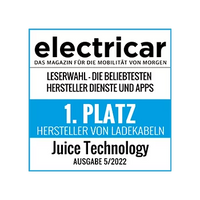volts, amps, watts
VOLT makes it exciting
Electrical voltage is measured in volts (V). If you were to compare current to the flow of water, volts would be the pressure with which water flows through a water pipe, and electrical voltage would be the pressure with which electrons flow through an electrical line. Today, standard household sockets throughout Europe provide 230V alternating current. In North America, this is only 115V. Wikipedia provides a clear map of the standards in different countries.
AMPERE is strong
The current strength is measured in amperes (A). Let's compare it again with a water pipe: the larger the diameter of the pipe, the more water flows through the pipe and the greater the amount of water and thus the water or current strength. Amperes therefore indicate how many electrons pass through a defined cross-section in a certain period of time.
WATT makes the sales
The kWh (kilowatt hours) are the number of kilowatts times hours of operating time required to power an electrical device.

kW, kWh or what?
A trick to make you as cool as James Bond sipping his martini as an e-driver: get used to using technical terms correctly and casually. Many people find it particularly difficult to distinguish between kW and kWh - but it's actually quite simple:kW (kilowatt) stands for power. Simply put, it is force.
kWh (kilowatt hours) represents an amount of energy. Simply put, it is the amount of energy required when the aforementioned force is applied for 1 hour.
So:
The charging power is calculated in kW. "Per hour" is out of place here - a power is a power. A combustion engine does not produce 136 hp per hour. It produces 136 hp. Instead, it is correct that you can charge 22 kWh per hour. Kilowatt hours are an amount of energy or work.How can you remember that? With 22 kWh you can drive for an hour if you manage to keep the consumption indicator in the Model S (orange pointer to the right of the speedometer) at 22 kW (without h). This is the case at around 100 km/h. If you drive faster, the consumption indicator will show (for example) 44 kW. This would mean that the same 22 kWh are used up after just half an hour. Conversely, with a 22 kW charge I can "recharge" the energy required for this - namely 22 kWh - in an hour. But if my charger only has 11 kW power, I can only charge 11 kWh in an hour. So it takes me 2 hours to recharge the 22 kWh.
An example makes it understandable
As we know, a large battery in the Tesla Model S has a capacity of 85 kWh. That is enough energy to power a hairdryer with 1000 W (= 1 kW) to dry your hair for 85 hours.
For specialists: Self-discharge etc. are neglected.
For hairdressers: If your hair is brittle, only blow-dry for 40 hours.
Those who think ahead will power for longer
The electrical installation and the fuse in the building determine how much "electricity" can be drawn. Of course, the supply lines must have the required diameter.
In general, all information here is for informational purposes only. It reflects the opinion of numerous experts who were consulted to the best of our knowledge and belief. For legal reasons, however, we must also decline any liability and emphasize that each user is responsible for his own actions. Installations can also vary from place to place and, for example, due to wear and tear on the contacts, poorly installed sockets or cables that have been chafed when pulled into the pipes, they can become hot even when the power is drawn from a low level. In the worst case scenario, this can lead to an ignition before the fuse, which may be far away, is triggered. Common sense is therefore always a good guide and it is advisable to regularly touch the plug and cable to check the heat build-up.
In practice, we mainly encounter the following constellations in Europe:
- 230V 10A (mainly in Switzerland). If the house is not very old, you can load up to 13A.
- 230V 13A (almost all of Europe, also all newer houses in Switzerland).
- 230V 16A (almost all Schuko sockets in Europe as well as the CEE16 blue plugs single-phase (called camping plugs))
- 400V 10A three-phase (in Switzerland there is still the T15 plug, but the supply lines are almost always fused to 16A)
- 400V 16A three-phase (in Switzerland there is the T15 and the similar looking T25 plug)
- 400V 16A three-phase CEE16 (fortunately the red round plug is a new EU and even worldwide standard)
- 400V 32A three-phase CEE32 (fortunately the red round plug is a new EU and even worldwide standard)
alternating current and direct current

alternating current

direct current
Source: swissgrid.ch

protection and standards
“The device complies with the standards” – what does that mean for the customer and how can you check it?
First of all, the sobering fact: the CE mark, which indicates compliance with standards, has so far been a self-declaration by the manufacturers. More and more critical voices are saying: "If there is no plaintiff, there is no judge."
In order to be able to better judge what is being served to you, here is some basic knowledge.
FI protection (residual current circuit breaker)
Today officially called "RCD" ( R esidual C urrent protective D evice)
Most people know that residual current protection is a must for electrical installations. But what is the purpose of such protection and how does it work?
Residual current devices prevent dangerously high fault currents to earth and can prevent life-threatening electric shocks.
The residual current device is installed in any circuit. It measures the amount of current flowing in and out of the circuit. If these two values are identical, there is no danger. However, if one value is greater than the other, this means that there is a defect somewhere in the circuit that is causing current to be conducted out of the circuit - and can therefore be transferred to people or objects. If this difference reaches a certain value, the residual current device is triggered and the circuit is interrupted in a flash.
FI Type A
Type A detects alternating residual currents as well as pulsating direct residual currents. This is the standard residual current device and it is cost-effective. It interrupts the circuit as soon as residual currents exceed 30mA (milliamperes) are reached.
FI Type A (EV)
A residual current device (FI/RCD) - specially developed for electric vehicles.
It is actually a combination of FI A and FI B. The latter, however, trips earlier than normal FI B to prevent any other upstream FI A from going blind. With a normal FI B, these would be pre-magnetized and lose their protective effect. A FI A (EV) interrupts the flow of current for alternating residual currents over 30 mA and for direct residual currents over 6 mA.
FI Type B
Every charging station must have its own residual current device in the supply line. The supply line must not have any branches (i.e. no other consumers may be connected). If several charging stations are supplied, the total must also be protected with a residual current device in order to catch cumulative fault currents. Instead of a costly residual current device type B, we recommend a residual current device type A (EV) with DC residual current detection.
standards
Standards set quality and safety standards. Although they are not legal in nature, they are binding in many areas. They are often a prerequisite for the correct approval of products - especially in the electrical sector.
In the still young field of electromobility, many of the relevant standards were only recommendations until around the end of 2015. In the meantime, however, these specifications have been improved to be very practical and since the beginning of 2016 they have represented a kind of minimum quality standard.
By affixing the well-known CE mark, manufacturers declare that they guarantee that their product meets the applicable requirements or complies with the applicable standards.
Electrical standards are set worldwide by the International Electrotechnical Commission (IEC) based in Geneva. The European Committee for Electrotechnical Standardization (CENELEC) sets the European standards, and each country sets its own country-specific standards.
These standards state how a device must be constructed in order to be considered 'safe'. The standards mainly relate to the following points:
legend
| A | Amp |
| V | volt |
| W | watt |
| VA | Volt amps = volts x amps = watts |
| kW | kilowatt (unit of measurement for power) |
| kWh | kilowatt hours (unit of measurement of energy) |
| AC | Alternating Current = alternating current. The public power grid is operated with alternating current. |
| DC | Direct Current = direct current. Batteries and accumulators work with direct current. |
| Hz | Hertz. Oscillation frequency in the alternating current network. In Central Europe, 50 Hz has been agreed upon, which means that the power grid changes polarization between + and - 50 times per second. |
| CCS | Combined Charging System (AC/DC charging) |
| CHAdeMO | Japanese plug for DC charging. Pronounced "tschademoo". |
| EN | European standard |
| CEE | International Commission on Rules for the Approval of Electrical Equipment |
| CEE16, CEE32, CEE63, CEE125 | Plugs standardized according to CEE, used worldwide. The number indicates the maximum amperes that can be passed through. |
| E-Driver | driver of an electric car |
| EV | Electric Vehicle |
| residual current device | residual current circuit breaker |
| FI A | FI, which detects alternating fault currents and switches off the current, usually from 30mA |
| FI B | FI that detects DC residual currents and switches off the current, usually from 10 to 30mA. Useless for use in electric cars, as this amount of DC residual current blinds upstream FI A and makes it impossible for them to be triggered. |
| FI A (EV) | FI that detects AC residual currents from 30mA and DC residual currents from 6mA and switches off the current. Developed specifically for the needs of EV charging. |
| IEC | International Electrotechnical Commission (standardization body) |
| Inductive charging | Wireless charging through magnetic fields |
| IP | International Protection Codes, describe the protection against contact/dust and against water |
| capacitive charging | Wireless charging using electric fields |
| Conductive charging | Charging through direct power connection via cable |
| RCD | Residual Current Device (FI circuit breaker) |
| TCO | Total Cost Of Ownership (acquisition and operating costs over the entire period of use) |
| L | Abbreviation for the phase ("conductor") in cables and plug connections. In three-phase connections, the conductors are numbered L1, L2 and L3. |
| N | Abbreviation for the neutral conductor in cables and connectors. |
| PE | Abbreviation for the protective conductor (earth potential) in cables and plug connections. |
| phase | Conductor in a cable that carries the current from the mains to the switch or socket. Brown, grey or black sheath. Marked with “L”. |
| neutral conductor | Transports electricity from the consumer back into the grid so that the balance is created. Yellow or blue sheath. Designation "N". Colloquially often called "neutral conductor". |
| protective conductor | Conductor that carries the potential body current to earth. Designation "PE", from potential earth. Colloquially often called "earth", "grounding" or "earth conductor". |
| Mode1, Mode2, Mode3, Mode4 | Charging modes, which refer to the way EVs are charged. |
| Type 1, Type 2, Type 3(ac) | Connector types specifically designed for charging EVs. |
















